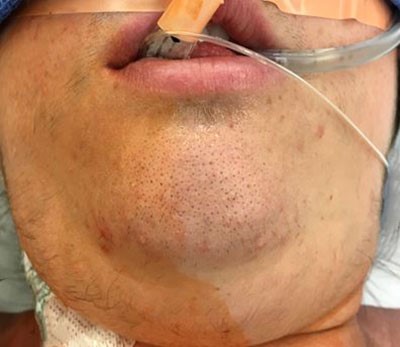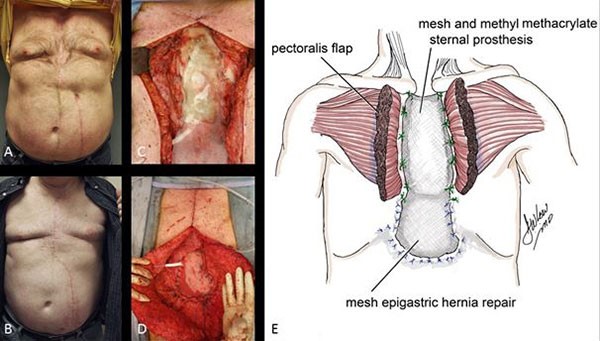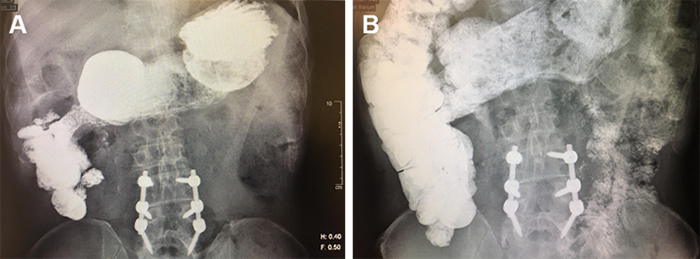Abstract
Background
At our institution, we have seen a recent increase in the number of requests to evaluate patients with possible forearm compartment syndrome after arterial cannulation or percutaneous cardiac interventions. Often, multiple failed attempts have been made to access the radial artery prior to successful cannulation or abortion of the procedure.
Summary
We present a case that highlights the morbidity of forearm compartment syndrome, how to diagnose increasing compartment pressures early, and a simple technique to halt continued bleeding into the forearm compartments in an attempt to minimize the likelihood of developing compartment syndrome. We have concluded that early diagnosis of compartment syndrome can help avoid permanent damage to nerve, muscle, and hand function.
Conclusion
Missed or untreated forearm compartment syndrome has devastating functional consequences resulting in varying degrees of sensory and motor loss in the affected extremity. Surgical treatment of compartment syndrome, even if performed prior to permanent nerve and muscle damage, is associated with significant morbidity. There has been an increased incidence of forearm compartment syndrome after radial artery cannulation. Often, nonsurgical maneuvers can be implemented to prevent compartment syndrome if initiated early enough.7 Most importantly, it is necessary to promptly identify impending compartment syndrome so that surgical intervention can either be prevented or initiated to help preserve extremity sensory and motor function if compartment syndrome develops.
Key Words
Compartment syndrome, forearm, arterial cannulation, hematoma
Case Description
Missed or untreated forearm compartment syndrome has severe consequences, including paralysis, loss of sensation, and muscle infarction, which leads to contracture. Forearm compartment syndrome occurs most commonly after extremity trauma1 that results in significant intracellular edema within muscle that is confined by non-yielding fascial compartments. Hematoma formation from vascular injury associated with the trauma adds volume to the compartment and subsequently increases pressure. Reperfusion injury after restoration of blood flow into, or out of, the forearm following prolonged tissue ischemia is also a common cause of compartment syndrome. Much less commonly, forearm compartment syndrome can be caused by high-voltage electrical injury, snake bites, arterial cannulation in critical care monitoring,2,3 intravenous line extravasation,4 and illicit drug injections.5
Radial artery cannulation for hemodynamic monitoring and coronary procedures is becoming more common at our institution. Hematoma formation from arterial injury during arterial access or after catheter removal is uncommon, but can have significant consequences if compartment syndrome develops. We present a case of compartment syndrome that developed after multiple unsuccessful attempts at placing a radial arterial line. The goal of our case report is to highlight the negative consequences of radial artery injury.
The patient, a 60-year-old Caucasian male, had a past history of coronary artery disease, atrial fibrillation, and mitral valve replacement. He underwent a radiofrequency catheter ablation procedure to control the atrial fibrillation four months previously, but this procedure was unsuccessful; the plan for this hospitalization was a repeated attempt at ablation to correct the persistent atrial fibrillation. The patient’s daily medications included oral apixaban, aspirin, prasugrel, fenofibrate, rosuvastatin, metoprolol, amlodipine/olmesartan, diltiazem, metformin, and sotalol.
In anticipation of the procedure, the patient discontinued his aspirin five days prior to the ablation and the apixaban was held the morning of the procedure. The prasugrel was continued due to the history of mitral valve replacement.
Preprocedure vitals and laboratory investigations were as follows: blood pressure was 141/89 mm Hg, heart rate was 114 beats per minute, temperature was 36.5°C, respiratory rate was 18 breaths per minute, oxygen saturation was 97%, the international normalized ratio 1.17, a physical performance test of 30.4 seconds, and a platelet count of 284 x 109 per L.
Prior to the procedure, attempts to place a right radial arterial catheter were made, but failed. Five additional attempts were made on the right before turning to the left radial artery, which was ultimately cannulated. After each failed attempt at cannulation of the right radial artery, pressure was applied directly over the artery access site. However, the actual duration of applied pressure was not specified.
The ablation procedure lasted approximately five hours. During the procedure, the patient received a total of 28,000 units of intravenous heparin, which maintained his activated clotting time between 299 and 395 seconds. For reversal, 60 mg of intravenous protamine was administered.
When the patient awakened from anesthesia, he immediately complained of significant pain in his right forearm and hand. He noted that his dorsal forearm was tense and began experiencing numbness in his fingers. Initially, a trial of elevation was attempted. After approximately one hour of elevation, the forearm pain progressively worsened, which led to a hand surgery consultation request. Upon evaluation, the patient’s blood pressure was 138/95 mm Hg, his heart rate 101 beats per minute, and his oxygen saturation was 99%. His right forearm was tense compared to the left forearm. Pain was elicited on active and passive extension at the wrist. Sensation to light touch was decreased from the fingertips into the palm. The right radial artery pulse was palpable and no pallor was noted. Multiple puncture sites were identified on the volar aspect of the wrist and forearm from the radial artery cannulation attempts. A Stryker needle was used to obtain pressures within the forearm compartments. A pressure of 54 mm Hg was measured in the flexor compartment of the forearm (normal pressure is less than 8 mm Hg).
Given the unknown duration of increased compartment pressures (due to the general anesthetic preventing appreciation of symptoms by the patient), the decision was made to take the patient to the operating room for a decompressive fasciotomy. In the operating room, a Brunner incision was made across the wrist and the carpal tunnel was released: a Brunner incision is a zigzag-style incision designed to cross skin flexion creases at a nonperpendicular angle to allow for improved exposure and to minimize contracture across the flexion crease as the scar forms. The incision was extended onto the forearm in a lazy-S fashion extending to the antecubital fossa. The flexor compartment is where the radial artery is located. As the flexor compartment fascia was opened, the muscle bellies bulged through the incision confirming increased compartment pressure. A small hematoma was found in the flexor compartment at the flexor carpi radialis muscle belly. There was no active bleeding identified and no obvious injury to the radial artery was seen. The muscles appeared healthy and reacted to electrocautery stimulation. The extensor compartment was palpated through the incision and found to be soft. Therefore, release of the extensor compartment was not performed. The skin at the proximal and distal aspects of the wound was loosely closed with 3-0 nylon suture. A DermaClose® device was used to progressively approximate the skin along the middle 25 cm of the incision. All sensation to the right forearm and hand returned within 24 hours. On postop day five, the DermaClose® device was removed. The remaining skin wound was closed with 3-0 nylon suture. The patient had no residual sequelae as a result of his compartment syndrome at his two-month follow-up visit.
Discussion
As transarterial coronary procedures are becoming more common, an increasing incidence of associated forearm compartment syndrome is being reported in the literature.6-8 Compartment syndrome in this setting is most often associated with over-anticoagulation7 resulting in hematoma formation or arterial spasm6 due to endothelial irritation.
Compartment syndrome develops when pressure within a space confined by fascia increases to the point where perfusion to the space is inhibited. Normal pressure within the fascial compartments of the extremities is less than 8 mm Hg. As intracompartmental pressures increase, arterial inflow and venous and lymphatic outflow is inhibited. This results in ischemia of the tissue within the compartment. Muscle can withstand a total ischemia time of approximately four hours without irreversible damage; however, total ischemia time of greater than eight hours uniformly results in irreversible changes. After one hour of ischemia, peripheral nerves have been found to still conduct impulses. After four hours of ischemia, neuropraxic damage occurs, which is still largely reversible. However, similar to muscle, peripheral nerves have irreversible axonotmesis damage after eight hours of ischemia.1,9
Conventional practice was to perform a fasciotomy when compartmental pressure approaches 30 mm Hg, which correlates with capillary filling pressure.10 However, fasciotomy is now generally recommended when intracompartmental pressure approaches 20 mm Hg below the patient’s diastolic pressure, particularly when symptoms are progressing, compartment pressures continue to increase, or if significant injury is present.1 Due to the suspected duration of his elevated compartment pressures, we proceeded with a fasciotomy in our patient, despite having intracompartmental pressures that were more than 20 mm Hg below diastolic pressure. If a hematoma and elevated compartment pressures developed at the time of the attempted artery cannulation, the patient may have had a total ischemia time exceeding eight hours, with general anesthesia masking the clinical symptoms. Additionally, the patient’s symptoms were worsening and did not improve with elevation. Upon entering the flexor compartment, the proximal muscles bulged through our incision, which confirmed our suspicion of markedly elevated intracompartmental pressures. Fortunately, despite the elevated pressures and the potential prolonged ischemia time, the patient’s muscles all contracted with electrocautery stimulation.
The patient had normal oxygen saturation and showed a continuous waveform on pulse oximetry in the affected forearm, which initially minimized our concern for compartment syndrome. Our assumption that the pulse oximetry waveform would be significantly affected by elevated compartment pressures was incorrect. Mars and colleagues11 published a small case series of ten patients where they compared oximetry waveform with compartment pressures. Based on these findings, the authors concluded that the presence of an oximeter signal does not imply adequate tissue perfusion and, therefore, is not a reliable aid in excluding increased compartment pressures—thus, it should not be used for the diagnosis or monitoring of impaired perfusion due to raised compartment pressures.
Tizon-Marcos and colleagues
7presented an institutional protocol for controlling active intracompartmental forearm bleeding after transradial procedures. The protocol is initiated in cases where there is suspicion of active bleeding at the first sign of swelling or pain in the forearm after removal of an arterial catheter. A blood pressure cuff is placed over the site of arterial cannulation. The cuff is inflated to 10–15 mm Hg below the patient’s systolic arterial pressure for 10–15 minutes. The goal of immediate pressure application is to stop the bleeding and spread the edema throughout the affected compart in the forearm. A pulse oximeter is placed on one finger of the same arm to ensure continued distal arterial flow during inflation. Two periods of 10–15 minutes of inflation are typically needed to stop any bleeding. All anticoagulants must be stopped and reversed if possible. Resolution of forearm symptoms within 5–10 minutes suggests the bleeding has stopped and the edema has spread. Urgent surgical consultation is considered if symptoms persist.
Conclusion
Missed or untreated forearm compartment syndrome has devastating functional consequences resulting in varying degrees of sensory and motor loss in the affected extremity. Surgical treatment of compartment syndrome, even if performed prior to permanent nerve and muscle damage, is associated with significant morbidity. There has been an increased incidence of forearm compartment syndrome after radial artery cannulation. Often, nonsurgical maneuvers can be implemented to prevent compartment syndrome if initiated early enough.7 Most importantly, it is necessary to promptly identify impending compartment syndrome so that surgical intervention can either be prevented or initiated to help preserve extremity sensory and motor function if compartment syndrome develops.
Lessons Learned
Forearm compartment syndrome is associated with significant morbidity, particularly when there is a delay in diagnosis. Prompt initiation of certain maneuvers may help avoid rising compartment pressures associated with attempted arterial cannulation.
Authors
Hill BC, Isaac M, Tavana ML
Correspondence Author
Brian C. Hill, MD
Medical University of South Carolina
Department of Surgery
Division of Plastic, Reconstructive, and Hand Surgery
96 Jonathan Lucas St.
Charleston, SC 29425
United States of America
843-792-8816
hillbri3@gmail.com
Author Affiliations
Medical University of South Carolina
Department of Surgery
Division of Plastic, Reconstructive, and Hand Surgery
96 Jonathan Lucas St.
Charleston, SC 29425
United States of America
Disclosure
The authors have no conflicts of interest or financial disclosures.
References
- Whitesides TE, Heckman MM. Acute compartment syndrome: Update on diagnosis and treatment. J Am Acad Orthop Surg. 1996;4:209-218.
- Qvist J, Peterfreund RA, Perlmutter G. Transient compartment syndrome of the forearm after attempting radial artery cannulation. Anesth Analg. 1996;83:183-185.
- Halpern AA, Mochizuki R, Long CE 3d. Compartment syndrome of the forearm following radial-artery puncture in a patient treated with anticoagulants. J Bone Joint Surg. 1978;60:1130-1137.
- Edwards JJ, Samuels D, Fu ES. Forearm compartment syndrome from intravenous mannitol extravasation during general anesthesia. Anesth Analg. 2003;96:245-6.
- Funk L, Frover D, de Silva H. Compartment syndrome of the hand following intra-arterial injection of heroin. J Hand Surg. 1999;24(3):366-367.
- Araki T, Itaya H, Yamamoto M. Acute compartment syndrome of the forearm that occurred after transradial intervention and was not caused by bleeding or hematoma formation. Catheter Cardiovasc Interv. 2010;75:362-5.
- Tizon-Marcos H, Barbeau GR. Incidence of compartment syndrome of the arm in a large series of transradial approach for coronary procedures. J Interv Cardiol. 2008;21:380-4.
- Lin YJ, Chu CC, Tsai CW. Acute compartment syndrome after transradial coronary angioplasty. Int J Cardiol. 2004;97:311.
- Whitesides TE, Harada H, Morimoto K. Compartment syndromes and the role of fasciotomy, its parameters and techniques. Instr Course Lect. 1977;26:179-196.
- Mubarak SJ, Owen CA, Hargens AR, et al. Acute compartment syndromes: diagnosis and treatment with the aid of the wick catheter. J Bone Joint Surg Am. 1978;60:1091-1095.
- Mars M, Hadley GP. Failure of pulse oximetry in the assessment of raised limb intracompartmental pressure. Injury. 1994;25:379-81.




